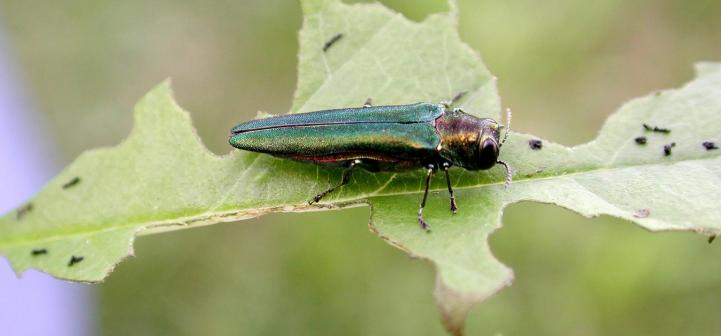Invasive Species: Commelina benghalensis, Benghal Dayflower
Benghal dayflower, or tropical spiderwort, is an annual or perennial creeping herb that is on the Federal Noxious Weed List. Leaves are alternate, lilylike, and 1.2 to 2.8 in. (3 to 7 cm) long and often have reddish hairs toward their tips. Aboveground flowers are very small with relatively large lilac to blue petals and are present from the spring into the fall. Underground flowers, which grow on burrowing rhizomes, are white and very small. The fruit is a capsule containing two seeds. The seeds are ribbed, grayish brown, and about 0.08 in. (2 mm) long. Benghal dayflower invades areas with moist soil, including roadsides, grasslands, and other disturbed areas. It is especially problematic in pastures and crop fields, where it forms dense, pure stands that can smother other plants, such as low-growing crops. Benghal dayflower is native to Asia and Africa and was first found in the United States in 1963.
What are invasive species, and why should we be concerned about them?
Taxonomy: Scientific and Common Names for This Species
Commelinales > Commelinaceae > Commelina benghalensis L.
Synonym(s): tropical spiderwort, jio
Commelina benghalensis – USDA PLANTS Profile
Distribution Maps
Benghal dayflower – The reported distribution of this invasive species across the United States (Source: Invasive Plant Atlas of the United States)
Up-to-the-minute distribution maps and why they are important
Reporting This Invasive Species
What is the best way to report the occurrence of an invasive species?
How to report an invasive species sighting to EDDMapS – Early Detection & Distribution Mapping System
EDDMapS – Report an invasive species to EDDMapS.
County Extension Offices – Find your county Extension office on this map provided by USDA.
How to Identify
This invasive species can be identified by looking for the characteristics described in the paragraphs that follow.
Plant
Benghal dayflower, or tropical spiderwort, is an annual or perennial, creeping herb.
 |
 |
| Theodore Webster, USDA Agricultural Research Service, bugwood.org | Stanley Culpepper, University of Georgia, bugwood.org |
Foliage
Leaves are alternate, lilylike, and 1.2 to 2.8 in. (3 to 7 cm) long and often have reddish hairs toward their tips.
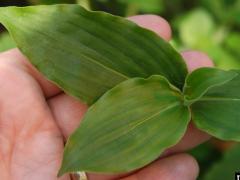 |
 |
| Theodore Webster, USDA Agricultural Research Service, bugwood.org | Herb Pilcher, USDA Agricultural Research Service, bugwood.org |
Flower
Aboveground flowers are very small with relatively large lilac to blue petals and are present from the spring into the fall. Underground flowers, which grow on burrowing rhizomes, are white and very small.
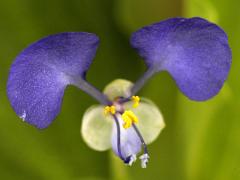 |
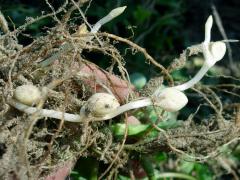 |
| Herb Pilcher, USDA Agricultural Research Service, bugwood.org | Byron Rhodes, University of Georgia, bugwood.org |
Fruit
The fruit is a capsule containing two seeds. The seeds are ribbed, grayish brown, and about 0.08 in. (2 mm) long.
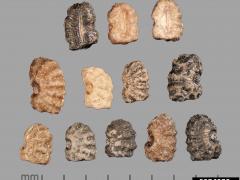 |
 |
| Julia Scher, USDA APHIS PPQ, bugwood.org | Julia Scher, USDA APHIS PPQ, bugwood.org |
Native Species That Resemble Benghal Dayflower
Commelina diffusa, spreading dayflower – Images at invasive.org
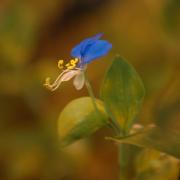 |
 |
|
Theodore Webster, USDA Agricultural Research Service, bugwood.org |
Forest and Kim Starr, Starr Environmental, bugwood.org |
Commelina erecta, whitemouth dayflower – Images at invasive.org
 |
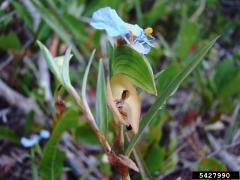 |
| Rebekah D. Wallace, University of Georgia, bugwood.org | Rebekah D. Wallace, University of Georgia, bugwood.org |
Additional Images for Benghal Dayflower
Benghal dayflower – Images at invasive.org
Learning Resources for Benghal Dayflower
Additional Information, Biology, Control and Management Resources
Control and management recommendations vary according to individual circumstances. Location, habitat, weather, and a variety of other conditions are factors that help determine the best treatment choice. To find the safest and most effective treatment for your situation, consult your state’s land-grant institution. If you will use chemicals as part of the control process, always refer to the product label.
United States Land Grant University System – Find your Land Grant University’s College of Agriculture, University Cooperative Extension Service, or other related partner on this map provided by USDA.
Domestic Programs Pest Evaluation – USDA Animal and Plant Health Inspection Service (APHIS) Plant Protection and Quarantine (PPQ)
Federal Noxious Weed Inspection Guide – USDA APHIS PPQ
Tropical Spiderwort Identification and Control in Georgia Field Crops – University of Georgia
Tropical Spiderwort Identification and Control – University of Florida
Commelina sp. Identification Key – Flora of North America
Federal Noxious Weed Disseminules of the United States – USDA APHIS
Invasive Weed Alert! – USDA Agricultural Research Service (ARS)
Commelina benghalensis, Benghal dayflower – Global Invasive Species Database
Commelina benghalensis – Pacific Island Ecosystems at Risk (PIER)
Invasive Species Compendium (Beta) – cabi.org
Prevention, Early Detection, and Eradication of Benghal Dayflower in Field Nurseries – University of Florida Institute of Food and Agricultural Sciences (IFAS) Extension
Fact Sheets – Mississippi State University
